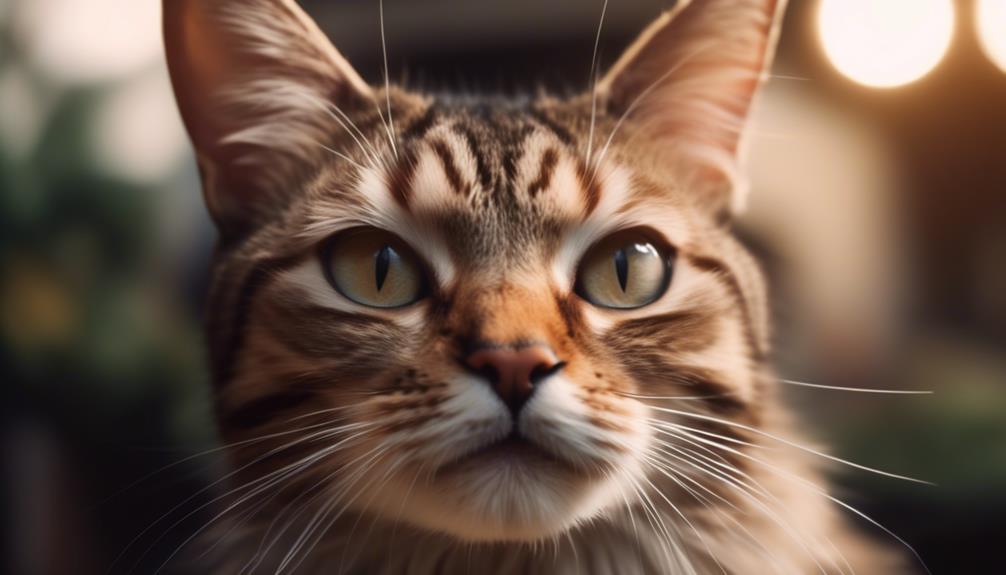Understanding the subtle nuances of cat communication is essential for any feline owner. While vocalizations and body language are commonly studied, the language of cat ears often goes unnoticed.
The intricate movements and positions of a cat's ears can convey a wealth of information about their emotional state and intentions. By gaining insight into these silent signals, cat owners can foster better understanding and stronger bonds with their feline companions.
Key Takeaways
- Cat ear positions provide valuable insight into emotional state and intentions.
- Understanding cat ear positions helps interpret feline communication and behavior.
- Observation and analysis of ear positioning, movement, and orientation are crucial.
- Decoding feline ear signals helps tailor interactions and create a supportive environment.
Understanding Cat Ear Positions
Frequently, understanding cat ear positions is crucial in interpreting feline communication and behavior, as it provides valuable insight into their emotional state and intentions. Cats, like many other animals, use body language cues to express themselves. Their ears are particularly expressive and can convey a wide range of emotions and intentions.
For instance, when a cat's ears are in a forward position, it generally indicates that the cat is feeling relaxed and content. On the other hand, flattened ears suggest that the cat is feeling threatened, defensive, or frightened. Additionally, a slight twitch in the ears may indicate that the cat is feeling agitated or irritated.
Observing these subtle cues can help individuals better understand a cat's behavior and respond appropriately, thereby improving the quality of care and interaction with the feline companion. By being attuned to these body language cues, individuals can provide a more comfortable and secure environment for cats, ultimately enhancing the human-feline bond.
Understanding cat ear positions is an essential aspect of deciphering cat behavior and fostering positive interactions.
Interpreting Cat Ear Language
Interpreting cat ear language involves careful observation and analysis of the positioning, movement, and orientation of a cat's ears to discern their emotional state and intentions. Nonverbal communication plays a significant role in understanding feline behavior, and the ears are a crucial aspect of this form of communication.
When a cat's ears are facing forward and slightly to the side, it indicates that the cat is relaxed and content. Ears that are perked up suggest that the cat is alert and possibly curious about something in its environment. Conversely, flattened ears pressed tightly against the head signal fear, aggression, or submission.
Observing the direction of ear movement can also provide insights into a cat's emotions. Ears twitching or flicking back and forth could indicate irritation or agitation, while slow, deliberate movements often signal a calm and relaxed state. Additionally, the orientation of the ears, whether they are tilted slightly forward or backward, can offer valuable cues about a cat's mood.
Understanding the nuances of cat ear language enables caregivers and owners to better serve their feline companions by responding appropriately to their needs and emotions.
Decoding Feline Ear Signals
The intricate and nuanced cues provided by a cat's ear language offer valuable insights into the feline's emotional state and intentions, enabling caregivers and owners to better understand and respond to their needs. Feline communication through ear movement is an essential aspect of their non-verbal language.
Observing a cat's ear signals can provide crucial information about their current state of mind. For instance, when a cat's ears are in a forward position, it often indicates that the feline is feeling relaxed and content. On the other hand, flattened ears suggest fear, anxiety, or aggression. Additionally, rapid flicking or twitching of the ears may signal irritation or overstimulation.
Understanding these subtle cues can help caregivers and owners tailor their interactions with their feline companions, ensuring a more harmonious and supportive environment. By decoding feline ear signals, individuals can enhance their ability to empathize with and care for their cats, promoting a deeper bond and a better quality of life for the feline.
Frequently Asked Questions
How Do Cats Use Their Ears to Communicate With Other Animals Besides Other Cats?
Cats use their ears to communicate with other animals through body language. Understanding feline communication and animal body language is crucial for interspecies communication. Cats may use their ears to signal interactions with dogs, sending clear messages through their ear movements.
Can a Cat's Ear Position Indicate if They Are Feeling Pain or Discomfort?
A cat's ear position can provide valuable clues about its emotional state and potential signs of pain or discomfort. Understanding ear language in cats can help caregivers identify and address their feline companion's needs promptly and effectively.
Are There Any Specific Ear Movements That Indicate a Cat Is Feeling Anxious or Stressed?
Ear language in cats is crucial for understanding feline stress signals. Specific ear movements such as flattening, twitching, or rotating can indicate anxiety or stress. Observing these cues can help in recognizing and addressing feline discomfort.
Do Different Breeds of Cats Have Different Ear Language Signals, or Are They Universal Among All Cats?
Different breeds of cats may exhibit some variation in their ear language signals, but many feline communication cues are universal. Understanding nonverbal cues such as ear positioning is crucial for interpreting a cat's emotional state and behavior.
Can a Cat's Ear Position Change Based on Their Mood or Emotions, or Is It Primarily a Form of Communication With Humans and Other Animals?
Cat behavior and body language are vital in understanding feline emotions and expressions. A cat's ear position can change based on mood and emotions, serving as both internal and external forms of communication with humans and other animals.


